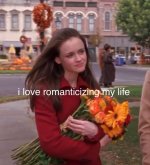Let’s get one thing straight:
No one turns heartbreak into a Pinterest board better than Gen Z.
Tears, trauma, and tragedy?
 Aesthetic
Aesthetic
Here’s a thread on why Gen Z romanticizes everything—even sadness.
Gone are the days when sadness was just… sad.
Now it's a soft filter, a Lana Del Rey track, and a black-and-white Instagram story that says:
"healing is not linear <3"
But why though? Why is Gen Z so into emotional struggle?
 Theory 1: Aesthetic Culture = Coping Mechanism
Theory 1: Aesthetic Culture = Coping Mechanism
Gen Z grew up in a world of curated visuals.
So when life sucks, we curate that too.
Sadness becomes soft lighting, scribbled poetry, rain on windows.
It’s tragic—but make it Tumblr-core.
 Theory 2: Content Is Currency
Theory 2: Content Is Currency
Pain, but posted.
Gen Z knows that if you're going through it, you might as well get a reel out of it.
Your breakdown becomes a playlist.
Your loneliness becomes a tweet that hits 400K likes.
Your vulnerability? Relatable content.
 Theory 3: Detachment Is Cool
Theory 3: Detachment Is Cool
Sincerity is cringey.
Crying into your pillow is weak.
But crying into your pillow while filming a “get ready with me” video to Mitski?
Now that’s iconic.
Romanticizing pain is how Gen Z makes it digestible.
 Theory 4: Mental Health Awareness (with a twist)
Theory 4: Mental Health Awareness (with a twist)
Yes, Gen Z talks more openly about depression, anxiety, and trauma.
But sometimes, that awareness slips into performative sadness.
It's not about healing. It's about looking like you're healing.
A fine line, right?
 Blame the Media?
Blame the Media?
Every Gen Z favorite is emotionally wrecked:
We want characters who stare blankly at neon lights and self-destruct beautifully.
 ️ Hot Take:
️ Hot Take:
Romanticizing sadness might make it easier to deal with—but it can also make us stuck in it.
We confuse emotional pain with personality.
We wear our sadness like it’s part of our brand.
 But hey—maybe it’s not all bad?
But hey—maybe it’s not all bad?
Romanticizing sadness is still a form of expression.
It gives people a sense of control, even in chaos.
If we can’t avoid the pain, we might as well give it good lighting and background music.
In conclusion:
Gen Z doesn’t just feel things—they design their feelings.
Heartbreak isn’t the end of the world—it’s a vibe.
And sadness?
It’s not a flaw. It’s a whole damn aesthetic.
Romanticizing pain isn’t weakness.
It’s Gen Z’s way of saying:
“We’re not okay. But we’re vibing.”
 What do you think?
What do you think?
Is Gen Z just finding new ways to cope?
Or are we glamorizing sadness a bit too much?
Let’s discuss in the replies.
(Or make a playlist about it.)
No one turns heartbreak into a Pinterest board better than Gen Z.
Tears, trauma, and tragedy?
Here’s a thread on why Gen Z romanticizes everything—even sadness.
Gone are the days when sadness was just… sad.
Now it's a soft filter, a Lana Del Rey track, and a black-and-white Instagram story that says:
"healing is not linear <3"
But why though? Why is Gen Z so into emotional struggle?
Gen Z grew up in a world of curated visuals.
So when life sucks, we curate that too.
Sadness becomes soft lighting, scribbled poetry, rain on windows.
It’s tragic—but make it Tumblr-core.
Pain, but posted.
Gen Z knows that if you're going through it, you might as well get a reel out of it.
Your breakdown becomes a playlist.
Your loneliness becomes a tweet that hits 400K likes.
Your vulnerability? Relatable content.
Sincerity is cringey.
Crying into your pillow is weak.
But crying into your pillow while filming a “get ready with me” video to Mitski?
Now that’s iconic.
Romanticizing pain is how Gen Z makes it digestible.
Yes, Gen Z talks more openly about depression, anxiety, and trauma.
But sometimes, that awareness slips into performative sadness.
It's not about healing. It's about looking like you're healing.
A fine line, right?
Every Gen Z favorite is emotionally wrecked:
- Rue from Euphoria
- BoJack Horseman
- Fleabag
- Wednesday Addams
- Joe from You
We want characters who stare blankly at neon lights and self-destruct beautifully.
Romanticizing sadness might make it easier to deal with—but it can also make us stuck in it.
We confuse emotional pain with personality.
We wear our sadness like it’s part of our brand.
Romanticizing sadness is still a form of expression.
It gives people a sense of control, even in chaos.
If we can’t avoid the pain, we might as well give it good lighting and background music.
In conclusion:
Gen Z doesn’t just feel things—they design their feelings.
Heartbreak isn’t the end of the world—it’s a vibe.
And sadness?
It’s not a flaw. It’s a whole damn aesthetic.
Romanticizing pain isn’t weakness.
It’s Gen Z’s way of saying:
“We’re not okay. But we’re vibing.”
Is Gen Z just finding new ways to cope?
Or are we glamorizing sadness a bit too much?
Let’s discuss in the replies.
(Or make a playlist about it.)

